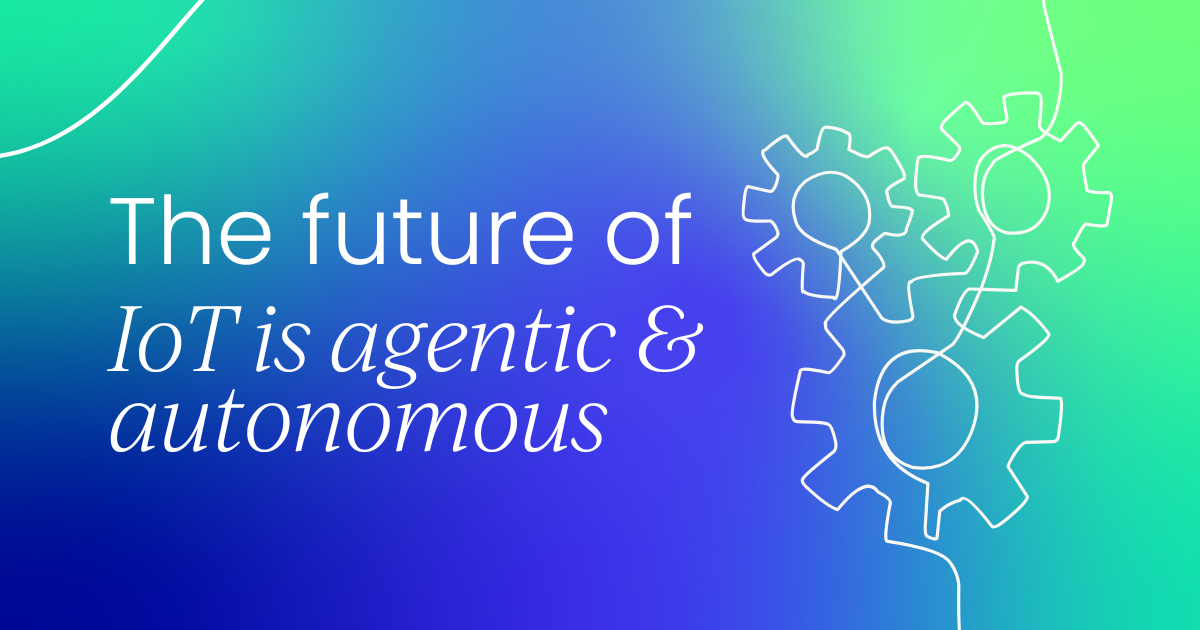
According to recent Cisco research, it’s projected that by 2028, 68% of all customer service and support interactions with tech vendors will be handled by agentic AI. This makes sense, as 93% of respondents in the same study predict that a more personalized, predictive, and proactive service will be possible with agentic AI.
Agentic AI represents a departure from traditional automation, as it enables AI agents to act independently, make decisions with minimal human input, and learn from context. Earlier systems required humans to connect and monitor the automated workflows. However, agentic AI agents have reasoning abilities, memory, and task awareness.
Because agentic AI can enhance both the operation and management of interconnected devices, this development is particularly relevant to the IoT (Internet of Things). It can proactively address network issues that originate from misconfigurations, which results in stronger security, smarter networks, and more productive teams.
This theme takes center stage at Agentic AI Summit New York on June 5, in the session led by Capital One’s Srinath Godavarthi on ‘Agentic AI: The next frontier of generative AI…from simple tasks to goal-oriented autonomy’.

Agentic AI vs. traditional AI: A structural shift
Agentic AI introduces an essential shift in how intelligent systems are architected and deployed, transitioning from task-specific and supervised models to autonomous and goal-oriented agents that can make real-time decisions and adapt to their environment.
Intelligence is mainly static and narrowly scoped in traditional AI systems; models are trained offline and embedded into rule-based workflows, usually operating in a reactive way. A conventional AI system could, for example, classify network anomalies or trigger alerts, but still rely on humans to contextualize signals and respond.
Agentic AI systems, however, are formed of AI agents that have agency:
- Memory. Continuous internal state across interactions and tasks.
- Autonomy. Ability to plan, execute, and adapt strategies without needing real-time human input.
- Task awareness. An understanding of task objectives, dependencies, and sub-task decomposition.
- Learning and reasoning. Ability to infer causality and change behavior depending on data and environmental signals.
As these agents have intention-driven behavior, they can decide how to perform a task, and which task to undertake based on system-level goals. Agentic AI systems often employ multi-agent coordination, where distributed agents communicate, negotiate, and delegate tasks across a network, which is ideal for large-scale and latency-sensitive environments, such as the Internet of Things (IoT).

Taking an industrial IoT context, a traditional AI pipeline would:
- Detect vibration anomalies in a turbine,
- Flag it for a technician via a dashboard,
- And wait for human triage.
In contrast, an agentic AI system would:
- Detect the anomaly in the turbine,
- Query contextual data (such as usage patterns),
- Dispatch a robot or an autonomous drone to inspect the anomaly,
- Adjust the operating parameters of any adjacent machinery,
- Alert a technician only after composing a full incident report and proposing actions.
Taking IoT into consideration, agentic AI eliminates the need for centralized control and brittle scripting. Instead, it promotes systems capable of evolving and optimizing over time, which is essential for those dynamic environments where resilience, latency, and scalability are crucial.
Why agentic AI matters for IoT
The intersection between agentic AI and IoT is a vital issue in distributed computing. IoT systems are becoming increasingly dense and latency-sensitive, and traditional centralized or rule-based automation is struggling to scale. Agentic AI is the solution to this challenge, allowing for decentralized and real-time decision-making at the edge.
Agentic systems work as goal-oriented and persistent software agents that are capable of adaptive planning, context retention, and multi-agent coordination. When they’re deployed across IoT networks, like cities, smart homes, or factories, AI agents allow for dynamic and autonomous orchestration of device behaviors and inter-device logic.
Smart homes
Agentic agents are able to autonomously manage demand-side energy consumption by dynamically adjusting lighting, HVAC, and storage systems based on real-time information and historical usage.
Smart cities
Agents can manage distributed load balancing across the infrastructure in municipal contexts. They dynamically re-route traffic through real-time edge sensor inputs or by coordinating energy resources through microgrids and public utilities, according to forecasted demand.
Industrial IoT
Agentic AI allows for runtime decisioning in factory or logistics networks for quality control, maintenance, and asset reallocation. If an agent embedded in a vibration sensor detects abnormal patterns, it can issue localized shutdowns while updating a model used by agents in adjacent systems.

Real-world applications
IBM ATOM (Autonomous Threat Operations Machine) is a system created to enhance cybersecurity operations through the use of agentic AI. It works by orchestrating multiple specialized AI agents that collaborate to detect, investigate, and respond to security threats with minimal human intervention.
Abdelrahman Elewah and Khalid Elgazzar developed the IoT Agentic Search Engine (IoT-ASE) to address the challenges of fragmented IoT systems. These often impede seamless data sharing and coordinated management. By leveraging large language models (LLMs) and retrieval augmented generation (RAG) techniques, IoT-ASE can process large amounts of real-time IoT data.
Challenges and opportunities
With the increasing presence of agentic AI systems across IoT environments, several technical challenges need to be addressed. Edge computing still has limitations that create a critical challenge. Agents thrive on local autonomy, but many edge devices still don’t have enough compute power, energy efficiency, or memory to support complex and context-aware reasoning models under real-time constraints.
There are also trust and privacy concerns. Agents operate semi-independently, meaning that their decision-making has to be auditable and aligned with both security and data governance policies. Any agent hallucinations or misaligned goals can lead to real-world risks, particularly in safety-critical environments.
Inter-agent communication and communication is another challenge that needs to be addressed. Strong communication protocols and semantic interoperability are needed so that agents don’t become brittle or inefficient in collaborative tasks.
These challenges can, however, point to some opportunities. Developing open standards for agent behavior, audit traits, and coordination could lead to ecosystem-level interoperability. Feedback loops, task routing, and dynamic oversight are frameworks for human-agent collaboration that can blend human judgment with scalable automation.
Why this matters now
This convergence of agentic AI and IoT is happening in real-time. Organizations are pushing to deploy more intelligence and distributed systems, and the need for autonomous and goal-driven agents is an architectural need.
That’s why events like the Agentic AI Summit New York are so important. They offer a platform to showcase innovation and to confront the practical infrastructure, coordination, and safety challenges that exist with large-scale agentic deployments.
Co-located alongside the Generative AI Summit and the Chief AI Officer Summit, this event forms part of a broader conversation on how intelligence is being embedded not just at the system level, but also into leadership strategy and foundational model development—making it a key gathering point for those shaping the future of AI in all its forms.
Srinath Godavarthi’s session ‘Agentic AI: The next frontier of generative AI…from simple tasks to goal-oriented autonomy’ offers a deep dive into how agent-based systems are evolving from simple task execution into fully autonomous orchestration across industries.
As the convergence of agentic AI and IoT accelerates, keeping pace with how the ecosystem evolves is more important than ever. Platforms like IoT Global Network offer a window into the technologies, use cases, and players shaping this space.




